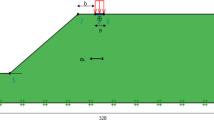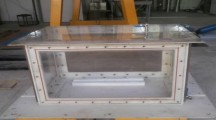Abstract
The liquefaction-triggering potential of foundation soils is still a difficult and questionable area as the methods of determination of the liquefaction-triggering potential are only valid for free-field level sites at the present time. However, liquefaction is a major problem especially in urban areas, which have a number of structures. The nature of the problem changes dramatically at city centers, which frequently comprise close spaces and buildings with basement floors. Even though there are some recent studies in this area, further research is required. Hence, this study is focused on the liquefaction behavior of foundation soils of adjacent buildings and buildings with basement floors (i.e., floors under the ground surface). For this purpose, 3D finite-difference-based analyses were performed for generic sites using different soil, structure, and earthquake parameters. The results obtained for the structures with basements are compared with those of structures with no basement. It was shown that the presence of basements decreases the possibility of liquefaction as compared to similar structures with no basements. Similarly, analyses were performed for adjacent structures, and the corner structures in a set of adjacent structures were found to be more vulnerable to liquefaction as compared to the ones in the center.













Similar content being viewed by others
References
Harder LF Jr., Boulanger RW (1997) Application of Kσ and Kα correction factors. In: Proceedings of NCEER workshop on evaluation of liquefaction resistance of soils 1997, NCEER-97-0022, National Center for Earthquake Engineering Research, SUNY Buffalo, Buffalo, NY, pp 167–190
Booker JR, Rahman MS, Seed HB (1976) GADFLEA—A computer program for the analysis of pore pressure generation and dissipation during cyclic or earthquake loading. Report no. EERC 76-24, Earthquake Engineering Research Center, University of California at Berkeley, Berkeley, California
Boulanger RW (2003a) Relating Kα to relative state parameter index. J Geotech Geoenviron Eng ASCE 129(8):770–773
Boulanger RW (2003b) High overburden stress effects in liquefaction analyses. J Geotech Geoenviron Eng ASCE 129(12):1071–1082
Cetin KO, Seed RB (2004) Nonlinear shear mass participation factor (rd) for cyclic shear stress ratio evaluation. Soil Dyn Earthq Eng 24(2):103–113
Cetin KO, Seed RB, Kiureghian AD, Tokimatsu K, Harder LF Jr, Kayen RE, Moss RES (2004) SPT-based probabilistic and deterministic assessment of seismic soil liquefaction potential. J Geotech Geoenviron Eng ASCE 130(12):1314–1340
Cetin KO, Unutmaz B, Jeremic B (2012) Assessment of seismic soil liquefaction triggering beneath foundation systems. J Soil Dyn Earthq Eng 43:160–173
Dashti S, Bray J (2013) Numerical simulation of building response on liquefiable sand. J Geotech Geoenviron Eng. https://doi.org/10.1061/(ASCE)GT.1943-5606.0000853
Dashti S, Bray J, Pestana J, Riemer M, Wilson D (2010a) Centrifuge testing to evaluate and mitigate liquefaction-induced building settlement mechanisms. J Geotech Geoenviron Eng. https://doi.org/10.1061/(ASCE)GT.1943-5606.0000306
Dashti S, Bray J, Pestana J, Riemer M, Wilson D (2010b) Mechanisms of seismically induced settlement of buildings with shallow foundations on liquefiable soil. J Geotech Geoenviron Eng. https://doi.org/10.1061/(ASCE)GT.1943-5606.0000179
Green RA, Mitchell JK, Polito CP (2000) An energy-based pore pressure generation model for cohesionless soils. In: Smith DW, Carter JP (eds) Proceedings of John Booker Memorial symposium—developments in theoretical geomechanics. Balkema, Rotterdam, pp 383–390
Hayden CP, Zupan JD, Bray J, Allmond J, Kutter B (2015) Centrifuge tests of adjacent mat-supported buildings affected by liquefaction. J Geotech Geoenviron Eng. https://doi.org/10.1061/(ASCE)GT.1943-5606.0001253
Idriss IM, Sun JI (1992) Users manual for SHAKE91, A computer program for conducting equivalent linear seismic response analyses of horizontally layered soil deposits, program modified based on the original SHAKE program published in December 1972, Schnabel, Lysmer, and Seed
Iwasaki T, Tokida K, Tatsuko F, Yasuda S (1978) A practical method for assessing soil liquefaction potential based on case studies at various sites in Japan. In: Proceedings of 2nd international conference on microzonation, San Francisco, pp 885–896
Iwasaki T, Tokida K, Tatsuoka F, Watanabe S, Yasuda S, Sato H (1982) Microzonation for soil liquefaction potential using simplified methods. In: Proceedings of 2nd international conference on microzonation, Seattle, pp 1319–1330
Karimi Z, Dashti S (2016) Seismic performance of shallow founded structures on liquefiable ground: validation of numerical simulations using centrifuge experiments. J Geotech Geoenviron Eng. https://doi.org/10.1061/(ASCE)GT.1943-5606.0001253
Luna R, Frost JD (1998) Spatial liquefaction analysis system. J Comput Civil Eng 12:48–56
Martin GR, Finn WDL, Seed HB (1975) Fundamentals of liquefaction under cyclic loading. J Geotech Eng Div 101(59):423–438
Mason HB, Trombetta NW, Chen Z, Bray J, Hutchinson TC, Kutter BL (2013) Seismic soil–foundation–structure interaction observed in geotechnical centrifuge experiments. Soil Dyn Earthq Eng 48(1):162–174
NCEER (1997) In: Youd TL, Idriss IM (eds) Proceedings of NCEER workshop evaluation of liquefaction resistance of soils. NCEER-97-0022. 31 Dec 1997
Nemat-Nasser S, Shokooh A (1979) A unified approach to densification and liquefaction of cohesionless sand in cyclic shearing. Can Geotech J 16(4):659–678
Polito CP, Green RA, Lee J (2008) Pore pressure generation models for sands and silty soils subjected to cyclic loading. J Geotech Geoenviron Eng 134(10):1490–1500
Seed RB, Harder LF (1990) SPT-based analysis of cyclic pore pressure generation and undrained residual strength. In: Proceedings of H. Bolton Seed memorial symposium
Seed HB, Idriss MI (1971) Simplified procedure for evaluating soil liquefaction potential. J Soil Mech Found Div 97(9):1249–1273
Seed HB, Tokimatsu K, Harder LF, Chung RM (1985) The influence of SPT procedures in soil liquefaction resistance evaluations. J Geotech Eng ASCE 111(12):1425–1445
Trombetta NW, Mason HB, Chen Z, Hutchinson TC, Bray J, Kutter BL (2013) Nonlinear dynamic foundation and frame structure response observed in geotechnical centrifuge experiments. Soil Dyn Earthq Eng 50(1):117–133
Unutmaz B, Cetin KO (2012) Post-cyclic settlement and tilting potential of mat foundations. Soil Dyn Earthq Eng 43(1):271–286
Vucetic M, Dobry R (1991) Effect of soil plasticity on cyclic response. J Geotech Geoenviron Eng ASCE 117(1):89–107
Youd TL, Idriss IM (2001) Liquefaction resistance of soils: summary report from the 1996 and 1998 NCEER/NSF workshops on evaluation of liquefaction resistance of soils. J Geotech Geoenviron Eng, ASCE 127(10):817–833
Author information
Authors and Affiliations
Corresponding author
Rights and permissions
About this article
Cite this article
Unutmaz, B. Effects of basements and adjacent structures on liquefaction-triggering potential of foundation soils. Bull Earthquake Eng 16, 2757–2773 (2018). https://doi.org/10.1007/s10518-017-0303-7
Received:
Accepted:
Published:
Issue Date:
DOI: https://doi.org/10.1007/s10518-017-0303-7





